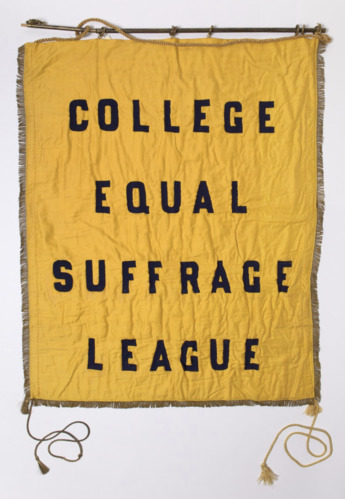Last updated: March 25, 2021
Place
Site of the College Equal Suffrage League Office

Norman B. Leventhal Map Center, Boston Public Library
Founded by Radcliffe alumnae Maud Wood Park and Inez Haynes Irwin in 1900, the College Equal Suffrage League (CESL) targeted the support of local college women and alumnae in the suffrage fight. While the CESL originated in Boston, suffragists quickly began establishing leagues throughout Massachusetts and across the country. In 1908, Maud Wood Park helped form a national organizational structure for CESL, headquartered in New York.1
The CESL reflected the founders’ belief in recognizing the work of the early women’s rights activists who fought for women to obtain higher education; she insisted it was college women’s obligation to carry on the fight of their foremothers.2 Park believed these college leagues would help revitalize the movement and encourage the involvement of younger women who considered the established suffrage organizations outdated.3
The CESL used an educational strategy to bring the suffrage question to campuses. Members organized meetings to introduce women’s suffrage to students, held debates to encourage discussion, and circulated flyers and publications to spread suffrage information.4 Members of the Boston CESL and other Massachusetts chapters also undertook active campaigning, particularly during the campaign for the 1915 suffrage referendum.5

Banner for the College Equal Suffrage League. (Credit: Schlesinger Library, Radcliffe Institute, Harvard University.)
Although the work of the CESL largely occurred on campuses, at some point it occupied office space at 585 Boylston Street. A “Busy Hive” of suffrage activity, this building also contained the offices of The Massachusetts Woman Suffrage Association, The Woman's Journal, the Boston Equal Suffrage Association for Good Government, and the Boston chapters of the Woman Suffrage Party.6

585 Boylston Street, the home of several suffrage organizations. (Credit: Boston Public Library.)
Footnotes:
- Sharon Hartman Strom, “Leadership and Tactics in the American Woman Suffrage Movement: A New Perspective from Massachusetts,” The Journal of American History 62, no. 2 (1975): 296-315.
- Patricia Marzzacco, “ ‘The Obligation of Opportunity’: Maud Wood Park, The College Equal Suffrage League and the Response of Women Students in Massachusetts Colleges, 1900-1920.” (PhD diss., Harvard University, 2003), 30-34.
- Marzzacco, “‘The Obligation of Opportunity,’" 30.
- Barbara Berenson, Massachusetts in the Woman Suffrage Movement (Charleston, South Carolina: The History Press, 2018), 100.
- Marzzacco, “‘The Obligation of Opportunity.’"
- Maud Wood Park, “Busy Hive Full of Workers for Women,” The Boston American, February 23, 1913.
